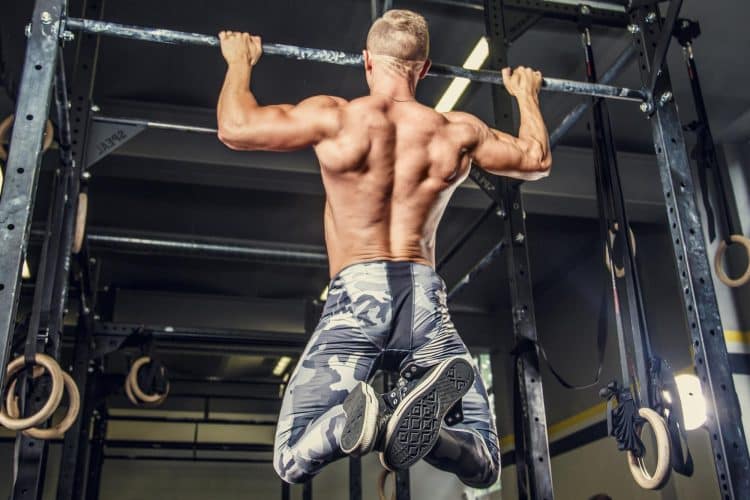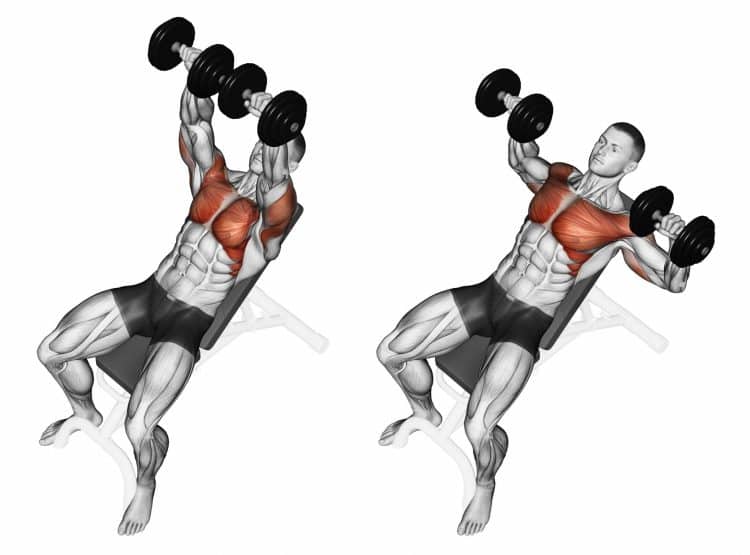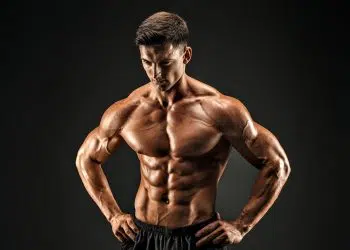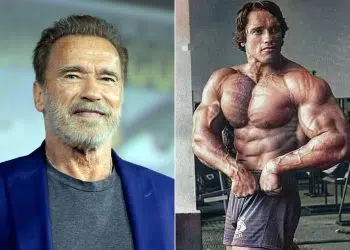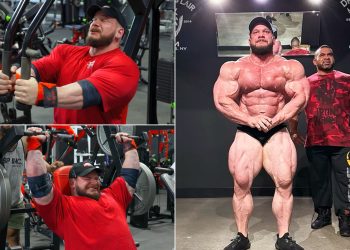Have you ever stopped to think about how much time you spend resting during your workouts? Take it from me; it’s more than you realize! For example, if you do 20 sets and rest 90 seconds between each one, that adds up to a whopping thirty minutes of downtime!
Do more sets or rest longer, and that 30 minutes can quickly turn into an hour or more. After all, many workouts contain 30-plus sets, especially those high-volume training plans that are so popular right now.
When I first realized how much of my workout was spent not training, I started looking for ways to save time and make my training programs more efficient. After all, life is too short to spend it sitting on a bench watching the clock.
I learned that cutting out junk sets and overlapping exercises could slash my workouts in half, and focusing almost exclusively on compound movements saved even more time.
Workouts that used to take two hours were over and done in under 60 minutes. Less time in the gym meant more time for rest and recovery, which really helped maximize my progress. With workouts taking less time, I had fewer excuses not to go to the gym and missed fewer training sessions.
However, another strategy proved to be an even bigger time-saver – supersets.
Level Up Your Fitness: Join our 💪 strong community in Fitness Volt Newsletter. Get daily inspiration, expert-backed workouts, nutrition tips, the latest in strength sports, and the support you need to reach your goals. Subscribe for free!
Supersets involve doing two exercises back-to-back, e.g., push-ups and pull-ups. Doing supersets halves the amount of time you spend resting, making workouts as time efficient as possible.
I now build all my workouts around supersets, so I’m either in and out of the gym in minutes instead of hours or cramming more training volume into less time. I rarely do regular sets, and when I do, I usually get impatient during the rest periods.
In this article, we share our latest chest and back superset workout designed to pack on mass and build strength in less time.
Chest and Back Anatomy Basics

Chest and back anatomy actually covers a lot of muscle acreage. After all, your chest and back are basically your entire torso! As such, your chest and back superset workout involves quite a few important muscles:
Pectoralis major
Known as your pecs for short, this is your most significant chest muscle. The pecs are made up of three sets of fibers, commonly referred to as heads: clavicular (upper), sternal (middle), and costal/abdominal (lower). A good chest workout hits all three pec heads reasonably equally. The functions of the pecs are adduction, horizontal extension, and medial rotation of the shoulder joint.
Pectoralis minor
Pec minor lies beneath the upper part of the pectoralis major. While it doesn’t contribute much to your chest size, it is nonetheless an important muscle. The functions of the pec minor are stabilization, depression, abduction, protraction, internal rotation, and downward rotation of the scapula.
Deltoids
The deltoids are your most prominent shoulder muscles. Like the pecs, there are three groups of fibers called heads: anterior (front), medial (middle), and posterior (rear). The anterior deltoid works with the pecs, while the posterior deltoid works with the back muscles. All three are involved in every upper body exercise you do, either as synergists (helper muscles) or stabilizers to prevent unwanted movement.
Serratus anterior
This muscle is so-called because it looks like the edge of a serrated blade. Located toward the outside of your chest, the serratus anterior helps keep your scapulae flat against your rib cage. While you’ll need to be pretty lean to see this muscle, it looks pretty cool when you can. It’s heavily involved in most pushing and pulling exercises.

Rotator cuff
The rotator cuff is the collective name for the four small muscles that control and stabilize your shoulder joint. The rotator cuff muscles are the supraspinatus, infraspinatus, teres minor, and subscapularis. While you can’t see your rotator cuff, they are critical for the safe and effective performance of all chest and back exercises.
Triceps brachii
The triceps brachii, or triceps for short, are located on the back of your upper arms. The triceps extend your elbows and also help extend your shoulders. There are three triceps heads: long, medial, and lateral. All three are involved in most chest/pushing exercises, while the long head works in several back/pulling exercises, albeit quite weakly.
Latissimus dorsi
Located on either side of your torso, your latissimus dorsi or lats are your most prominent back muscles. When well-developed, the lats look like broad, muscular wings. The functions of the lats are extension, adduction, and medial rotation of the shoulder joints.
Trapezius
Known as the traps for short, this large-diamond-shaped muscle covers much of your upper back. It comprises three sets of fibers – upper, middle, and lower. While the fibers of the traps are interconnected, they have individual functions. The upper traps are responsible for the elevation of your shoulder girdle, while the middle fibers are responsible for retraction. The lower fibers are mainly responsible for shoulder girdle depression.
Rhomboids
The rhomboids work with your mid-traps to pull your shoulder blades back and together, which is a movement called retraction. While the rhomboids are relatively small, they still contribute to the thickness of your upper back.
Biceps brachii
Almost all back exercises involve pulling, and that means your biceps also get a workout. Located on the front of your upper arm, the biceps are responsible for flexion of the elbow, supination of the forearm, and also play a minor role in shoulder flexion.
Forearms
As most back exercises involve pulling, you cannot avoid using your forearms, which create the grip you need to stay attached to the bar or handle you are using. Weak forearms could bring your back workout to a premature end, so many exercisers use lifting straps to enhance their grip. However, some direct grip training may be better than relying on external crutches.
The Lowdown on Supersets
Before we launch into our chest and back superset workout, it’s worth reviewing what supersets are and the types of supersets you can use in your workouts. Check out this guide for more information about supersets.
Firstly, a superset is when two exercises are performed back to back. For example, you could do a set of barbell curls immediately followed by a set of diamond push-ups to train both your biceps and triceps.
In a program, supersets are written like this:
- Barbell curls x 12
- Diamond push-ups x 12
On completion of the second exercise, you then rest a moment or two before repeating the superset the specified number of times.
Superset Variations
There are several ways to perform supersets, each with a specific purpose. The main superset variations are:
- Agonist or compound supersets – two exercises for the same muscle group, e.g., pull-ups and lat pulldowns.
- Agonist/antagonist or push/pull supersets – two exercises for opposing muscle groups, e.g., biceps curls and triceps pushdowns.
- Agonist/distant agonist supersets – two exercises for anatomically dissimilar muscle groups, e.g., leg curls and lateral raises.
- Agonist/opposing synergist supersets – one exercise for a large muscle group and one for an opposing small muscle group, e.g., bench press and biceps curls.
- Lower body/upper body supersets – one leg exercise followed by one torso or arm exercise, e.g., squats and dips.
- Post-exhaust supersets – a compound exercise followed by an isolation exercise for the same muscle group, e.g., shoulder press and front raises.
- Pre-exhaust supersets – an isolation followed by a compound exercise for the same muscle group, e.g., pec deck and chest presses.
While all these supersetting methods are effective, we’ll mainly use agonist/antagonist or push/pull supersets for our chest and back workout.
Superset Benefits
There are several compelling reasons to include supersets in your muscle-building workouts. These include:
A balanced workout – doing agonist/antagonist or push-pull supersets ensures that you do an equal number of sets for opposing muscle groups, e.g., biceps and triceps, quadriceps and hamstrings, and chest and back. This helps ensure that both muscles are equally well developed, which is important for function and aesthetics.
A better pump – supersets drive a lot of blood into the area you are working, producing a bigger, more powerful pump. Pumping a muscle full of blood enhances muscle growth by increasing nutrient saturation and stretching the fascia surrounding the muscle.
Better recovery between exercises – improving blood flow to your working muscles may speed up recovery from set to set. As such, you may be able to do more reps or use heavier weights for agonist/antagonist supersets compared to conventional or straight sets.
Less time spent resting – the most obvious benefit of supersets is that they half the time you spend resting. This will shorten your workouts or allow you to cram more training volume into your training session. Either way, supersets make good use of your valuable training time.
Superset drawbacks
While supersets are mostly effective and beneficial, there are a couple of drawbacks to consider, too:
Cardiovascular fatigue – doing back-to-back exercises, especially for large muscle groups like the chest and back, can create a lot of cardiovascular fatigue, which may interfere with your workout performance. That said, if you do get very out of breath doing supersets, this strongly indicates you need to work on your aerobic fitness.
Lower training weights – compound supersets, where you do similar exercises back-to-back, invariably mean using less weight for the second exercise. Fatigue will also increase from one superset to the next. As such, you’ll need to use lighter weights than with conventional sets. This is not an issue for bodybuilding but could be a drawback if you are training for strength.
Monopolizing training equipment – many supersets involve using two sets of equipment. This can be difficult in busy gyms, and you may find the equipment you were going to use is being used by someone else when you reach it. Don’t worry; we’ve done our best to avoid this problem by pairing exercises you can do with the same equipment.
More time pressure – doing supersets means you’ll have no time to dilly or dally between exercises. Instead, you finish your first exercise and must move as quickly as possible to the next. This can take some of the enjoyment out of your workouts, especially if you like to chat and chill between sets. Rushing from one movement to the next may also be stressful.
Chest and Back Superset Workout Overview
Now you know a little more about chest and back anatomy and how and why supersets work, it’s time to hit the weights and train!
Do the following workout 1-2 times per week on non-consecutive days, e.g., Monday and Thursday. Make it part of a weekly training split, where you train your remaining body parts on different days.
Level Up Your Fitness: Join our 💪 strong community in Fitness Volt Newsletter. Get daily inspiration, expert-backed workouts, nutrition tips, the latest in strength sports, and the support you need to reach your goals. Subscribe for free!
For example:
| Monday | Tuesday | Wednesday | Thursday | Friday | Saturday | Sunday |
| Chest & back | Legs & calves | Rest | Back & Chest | Rest | Shoulders & arms | Rest |
But, before you lift any weights, make sure you warm up thoroughly to minimize your risk of injury and improve workout performance. Start with a few minutes of easy cardio followed by dynamic mobility and flexibility exercises for your muscles and joints, focusing on your shoulders, elbows, and lower back. Read also how to Warm Up for Strength Training.
Warmed-up and ready? Then let’s get to work!
| # | Exercise | Sets | Reps | Recovery |
| 1a | Wide-grip bench press | 4 | 6-8 | 2 minutes |
| 1b | Pull-ups | |||
| 2a | Incline dumbbell press | 3 | 8-10 | 90 seconds |
| 2b | Single-arm dumbbell row | |||
| 3a | Cable crossovers | 3 | 12-15 | 60 seconds |
| 3b | Y pulldowns | |||
| 4a | Push-ups | 3 | 12-15 | 60 seconds |
| 4b | Straight arm pulldowns |
Related: Biceps and Triceps Superset Workout for Huge, Pumped Arms
Exercise Instructions
There are two ways to do most exercises – the right way and the wrong way. The right way is safe and effective and keeps the target muscles under tension. The wrong way is usually more dangerous and less effective, even if it allows you to lift heavier weights. Follow these instructions to ensure you’re doing the exercises in your workout correctly.
1a. Wide-grip bench press
Muscles targeted: Pectoralis major, deltoids, triceps.
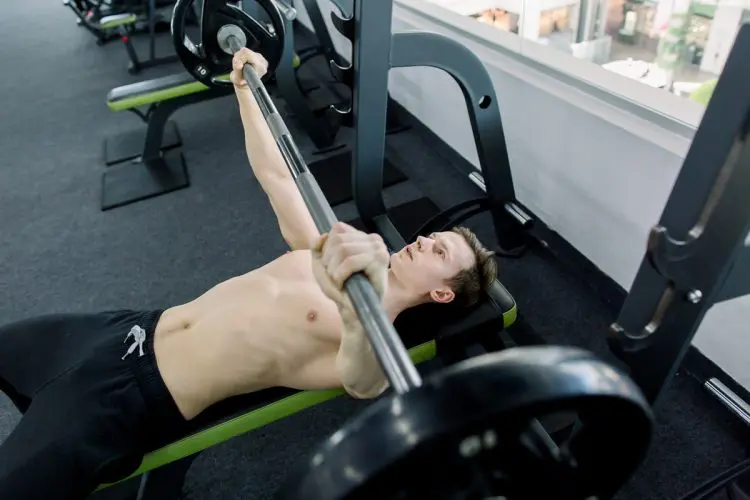
The bench press is a popular chest exercise. However, moving your hands a little wider makes it more effective. On the downside, you won’t be able to use as much weight compared to conventional bench presses. That said, this is a hypertrophy program and not a brute strength workout, so this doesn’t actually matter very much. Check your ego and enjoy a great chest-building workout despite the lower weight.
Steps:
- Lie on your bench so your eyes are below the bar. Hold the bar with an overhand grip so your hands are about six inches further apart than usual. Push your upper back into the bench and plant your feet firmly on the floor. Lift your chest and brace your core.
- Unrack the bar and hold it over your chest.
- Bend your elbows and lower the bar to your sternum. Keep your elbows away from the side of your body.
- Press the bar back up to arm’s length and repeat.
Tips:
- Experiment with the width of your hands to determine what feels the most comfortable and effective.
- Raise your feet and place them on the bench to possibly increase pec engagement.
- Pause with the bar lightly touching your chest to make this exercise harder.
Read more on wide-grip bench press
1b. Pull-up
Muscles targeted: Latissimus dorsi, biceps, trapezius, forearms.
Pull-ups are one of the best exercises for building wider lats. As an added advantage, most gyms have several places to do pull-ups, so they’re an ideal exercise for supersets. Can’t do pull-ups? Use a resistance band for assistance or a counterbalance pull-up machine. Alternatively, you can do lat pulldowns for your back.
Steps:
- Hold your pull-up bar with an overhand, slightly wider than shoulder-width grip. Hang with your arms straight, feet off the floor, shoulders down and back, and core braced.
- Without kicking or swinging, bend your arms and pull your chest up toward the bar.
- Lower yourself smoothly back down, and repeat.
Tips:
- The wider your hands, the greater the lat widening effect of this exercise will be.
- Use lifting chalk to stop your hands from slipping.
- Use a weight vest or weighted belt to make this exercise more challenging.
2a. Incline dumbbell press
Muscles targeted: Pectoralis major, deltoids, triceps.
Incline dumbbell presses work your upper/inner chest. However, if the angle of your bench is too high, you’ll end up working your shoulders more than your pecs. Set your bench to no more than 30 degrees for optimal pec engagement.
Steps:
- Adjust the angle of your bench to 30 degrees or less. Lie on the bench and hold a dumbbell in each hand, arms straight. Your palms should face down your body, i.e., a pronated grip.
- Pull your shoulders back and down and brace your core.
- Bend your elbows and lower the dumbbells out and down to your shoulders.
- Press the weights back up and together, and then repeat.
Tips:
- Lower the dumbbells as far as your flexibility and shoulder health allow.
- Do this exercise with a spotter for safety.
- Adjust the angle of the bench to see what works best for you, i.e., 10, 20, and 30 degrees.
2b. Single-arm dumbbell row
Muscles targeted: Latissimus dorsi, deltoids, biceps, forearms.
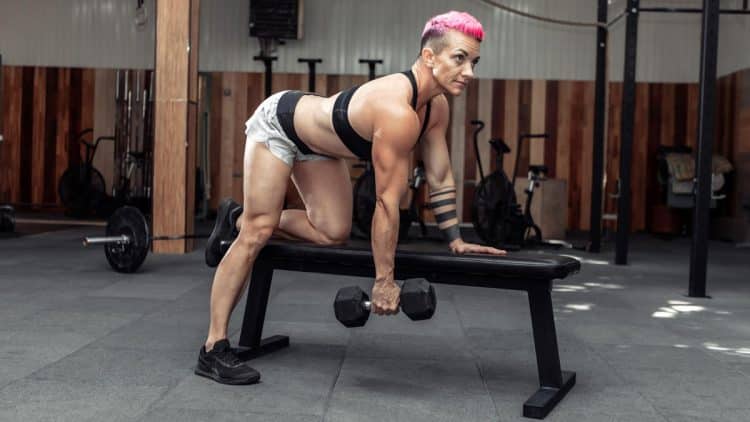
Where lat pulldowns and pull-ups are great for building back width, it’s rows that’ll make your back thicker. For superset convenience, take a dumbbell over to where you are doing incline presses so you can move quickly from one exercise to the next. Use the same bench for support so you can focus on pumping out as many reps as possible.
Steps:
- Hold a dumbbell in one hand and stand with your feet shoulder-width apart. Lean forward and place your free hand on your bench for support. Your upper body should be parallel to the floor. Let the dumbbell hang straight down, palm turned inward.
- Bend your arm and row the dumbbell up and into your lower ribs.
- Lower the weight and repeat.
- Do the same number of reps with your opposite arm.
Tips:
- Keep your knees slightly bent and your lower back arched throughout.
- Use lifting straps and/or chalk if necessary.
- Lead with your elbow and keep your wrist straight to maximize lat muscle engagement.
3a. Cable crossovers
Muscles targeted: Pectoralis major, deltoids.
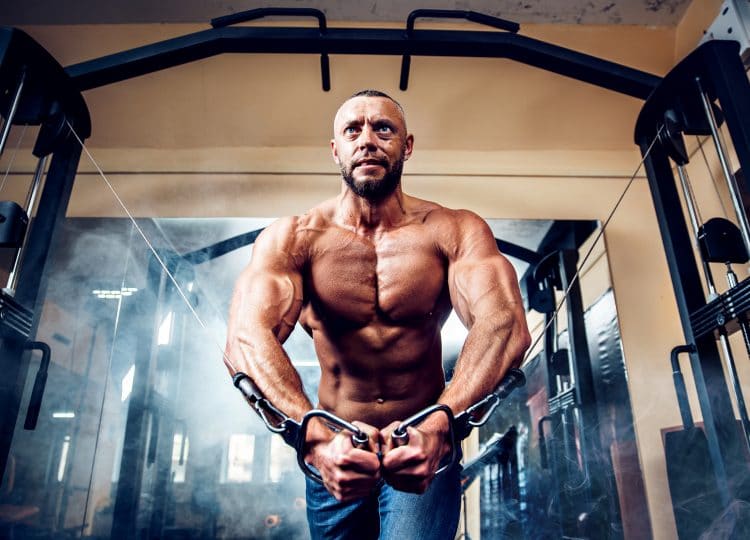
The cable crossover is a classic chest exercise. Unlike bench presses, chest presses, and push-ups, cable crossovers don’t put much tension on your triceps, so you can focus more on pushing your pecs to their limit. While this isn’t such a good exercise for building strength, it is excellent for building quality mass.
Steps:
- Attach D-shaped handles to the top pulleys of a cable crossover machine. Take one handle in each hand and stand between them, arms extended out at about shoulder height.
- Take a step forward and adopt a staggered stance for balance. Brace your core and bend your elbows slightly.
- Without bending your elbows further or leaning over, draw your arms forward and down so your hands meet in front of your hips.
- Raise your arms and repeat.
Tips:
- Keep your elbows slightly bent but rigid to avoid turning cable crossovers into another pressing exercise.
- Brace your core to keep your upper body stationary.
- This exercise works best with light to moderate weights. Go too heavy, and your technique will soon start to deteriorate.
3b. Y pulldowns
Muscles targeted: Latissimus dorsi, biceps.
While you probably won’t see many people doing this exercise, it’s an excellent back-builder and will make your lats wider. Performed using a cable crossover machine, it’s the perfect exercise to superset with crossovers for your chest. Use this move to fill in your lat gaps and build the ultimate V-taper.
Steps:
- Stand between the uppermost handles of a cable crossover machine and take one in each hand. Kneel in the middle of the machine with your arms outstretched to form a Y-shape.
- Lift your chest and pull your shoulders down and back.
- Bend your arms and pull your elbows into your sides.
- Extend your arms and repeat.
- Continue for the desired number of reps.
Tips:
- Pull your shoulders down and back to increase rhomboid and trapezius engagement.
- Lift your chest to increase upper back engagement.
- Pause at the midpoint of each rep to hammer your upper lats.
4a. Push-ups
Muscles targeted: Pectoralis major, deltoids, triceps, core.
The great thing about push-ups is that you can do them almost anywhere. As such, they’re perfect for supersets, as you can drop down and bang out your set next to your other paired exercise. Push-ups are also a very underrated chest exercise, especially when you do them after several other pec movements.
Steps:
- Squat down and place your hands on the floor with your fingers pointing forward and a little wider than shoulder-width apart.
- Walk your feet out and back so your body is straight. Brace your abs.
- Bend your arms and lower your chest to within an inch of the floor.
- Drive your hands into the floor and push yourself back up.
- Continue until you are unable to do any more clean reps.
Tips:
- Do not let your hips lift or sag; keep your body straight and tight throughout.
- Imagine you are squeezing your hands inward to maximize chest engagement.
- Drop to your knees and pump out a few more reps to extend your set beyond failure.
4b. Straight arm pulldowns
Muscles targeted: Latissimus dorsi, triceps (long head), core.
Straight arm pulldowns are one of only a few back isolation exercises. With no biceps involvement, you’re free to focus on pushing your lats to their limit. This is the ideal exercise to finish your back workout and will leave your lats pumped and exhausted.
Steps:
- Attach a straight bar to a lat pulldown machine.
- Hold the bar with an overhand, slightly wider than shoulder-width grip. Brace your core and pull your shoulders back and down.
- With straight arms, step back to tension the cable. Lean forward slightly from your hips.
- Without bending your elbows, push the bar down to your thighs.
- Raise your arms and repeat.
Tips:
- Experiment with different grip widths to see which you prefer.
- Keep your chest up, core tight, and lower back slightly arched.
- Use as big a range of motion as possible without letting the weights touch down.
Chest and Back Superset – FAQs
Do you have a question about our chest and back superset workout or training for hypertrophy in general? No problem, because we’ve got the answers!
1. Can I change any of the exercises in this workout?
Feel free to make changes to this workout if you are unable to perform any of the exercises. However, make sure you stay true to the spirit of the program, and avoid unbalancing it. For example, while doing seated cable rows instead of single-arm dumbbell rows is fine, doing lat pulldowns instead of rows is not. Choose similar exercises that involve the same muscles and plane of motion.
2. Is this workout suitable for beginners?
This workout is relatively high in volume and potentially pretty intense. As such, it’s best left to intermediate and advanced exercisers. Beginners should follow a basic full-body workout plan before attempting a body part split. Develop a basic foundation of fitness and strength before moving on to more advanced training programs.
3. Is this a bulking or cutting program?
Bulking and cutting have more to do with your diet than your workouts. Bulking (building muscle quickly) involves creating a significant calorie surplus so you gain weight relatively quickly. While some of this weight will be muscle tissue, some of it will be fat, too.
In contrast, cutting involves a calorie deficit and losing fat. It’s much harder to gain muscle during a cut, so the main focus is muscle maintenance.
So, this chest and back workout can be used for bulking or cutting, and what happens to your muscle mass and body composition depends on your diet.
4. How much weight should I use for the exercises in this workout?
We can’t answer this question because we don’t know how strong you are. Instead, you’ll need to experiment to find the right weight. This will take a workout or two, but you’ll figure it out!
Your chosen weight should take you close to failure within the prescribed rep ranges. For example, for the first two exercises, if you can do more than eight reps, the weight is too light, but if you can’t do six, it’s too heavy. Adjust the weights to keep you in the rep-range sweet spot.
However, you should also try to increase your weights or do an extra rep every week or so. This will ensure you keep making progress. But, never sacrifice good form for more weight. Your technique should not change even though you’re using heavier loads.
5. How long should I follow this program?
Even the best workouts have a limited shelf life. Your body will eventually get used to every program, and it’ll stop being effective. This is called hitting a plateau. However, it’s impossible to tell you when this will happen, as it varies from person to person. You’ll have to monitor your progress and decide for yourself if the program has stopped working.
Keep a training diary and monitor your training weights and reps; if you are unable to increase them for more than 2-3 weeks, your progress has probably stalled. Deload for a week, seek out another program and start over.
Closing Thoughts
Your workout time and energy are valuable, so don’t waste them sitting on a bench when you could be training. Supersets make your workouts more time-efficient and potentially better for building muscle.
Whether you use supersets to shorten your workouts or cram more sets into the same timeframe is up to you. Either way, supersets are a great way to make your training more productive.
Do this workout 1-2 times a week to build more upper body mass in less time.

